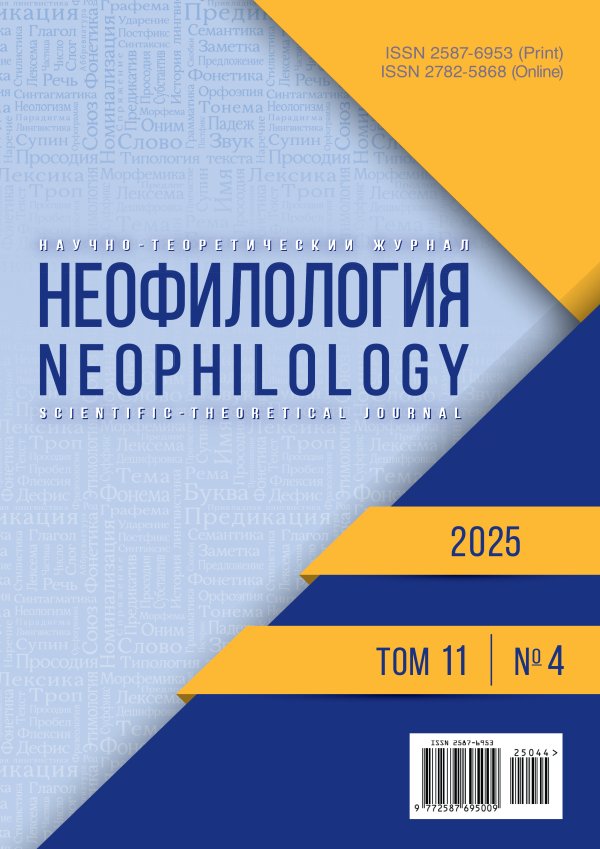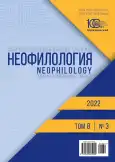Синестезия и персонификация в художественном тексте: лингвостилистический аспект
- Авторы: Дубовицкая М.А.1, Монастырецкая О.В.1, Филатова Н.П.1, Шаповалова О.Н.1
-
Учреждения:
- ФГБОУ ВО «Саратовский государственный технический университет имени Гагарина Ю.А.»
- Выпуск: Том 8, № 3 (2022)
- Страницы: 512-519
- Раздел: ЯЗЫКИ НАРОДОВ ЗАРУБЕЖНЫХ СТРАН (ГЕРМАНСКИЕ ЯЗЫКИ)
- URL: https://journal-vniispk.ru/2587-6953/article/view/301781
- DOI: https://doi.org/10.20310/2587-6953-2022-8-3-512-519
- ID: 301781
Цитировать
Полный текст
Аннотация
Проанализированы особенности функционирования в художественном тексте таких разновидностей метафоры, как синестезия и персонификация. Цель: выявление стилистического потенциала синестезии и персонификации в художественном тексте. Актуальность темы обусловлена необходимостью определения стилистических функций данных разновидностей метафоры в прозе австрийских авторов, малоизвестной и недостаточно исследованной в отечественной стилистике. Материалом исследования послужила проза австрийских авторов. Намеренно были выбраны произведения, созданные в разное время, что позволило вовлечь в область анализа метафоры, разнообразные как по структуре, так и по особенностям функционирования. Исследован стилистический потенциал метафор, под которым понимается способность данных языковых средств реализовывать определённые стилистические функции. Выводы: 1) язык австрийских писателей XIX – первой половины XX века характеризуется метафоричностью, составляющей эстетическую ценность их произведений; 2) большую роль в достижении образности художественного текста играют выразительные средства языка, в частности, синестезия и персонификация; 3) данные разновидности метафоры обладают достаточным стилистическим потенциалом для реализации основных функций в художественном стиле, а именно, характерологической, дескриптивной, эмотивной и оценочной; 4) для метафоры характерна полифункциональность, дающая возможность совместить описание с задачами характеристики, экспрессии и оценочности. Полученные данные составляют теоретическое значение исследования, а также могут быть использованы при обучении студентов-филологов.
Ключевые слова
Об авторах
М. А. Дубовицкая
ФГБОУ ВО «Саратовский государственный технический университет имени Гагарина Ю.А.»
Email: maria-mra@mail.ru
ORCID iD: 0000-0001-5412-5237
кандидат социологических наук, доцент кафедры «Переводоведение и межкультурная коммуникация»
410054, Российская Федерация, г. Саратов, ул. Политехническая, 77О. В. Монастырецкая
ФГБОУ ВО «Саратовский государственный технический университет имени Гагарина Ю.А.»
Email: olga.mona1968@yandex.ru
ORCID iD: 0000-0003-1160-390X
кандидат филологических наук, доцент кафедры «Переводоведение и межкультурная коммуникация»
410054, Российская Федерация, г. Саратов, ул. Политехническая, 77Н. П. Филатова
ФГБОУ ВО «Саратовский государственный технический университет имени Гагарина Ю.А.»
Email: nellyf@mail.ru
ORCID iD: 0000-0002-3113-6803
доцент кафедры «Переводоведение и межкультурная коммуникация»
410054, Российская Федерация, г. Саратов, ул. Политехническая, 77О. Н. Шаповалова
ФГБОУ ВО «Саратовский государственный технический университет имени Гагарина Ю.А.»
Автор, ответственный за переписку.
Email: Shapovalovaolga@yandex.ru
ORCID iD: 0000-0001-5876-6066
кандидат филологических наук, доцент кафедры «Переводоведение и межкультурная коммуникация»
410054, Российская Федерация, г. Саратов, ул. Политехническая, 77Список литературы
- Рубинштейн С.Л. Основы общей психологии. СПб.: Питер, 2000. 712 с.
- Лурия А.Р. Лекции по общей психологии. СПб.: Питер, 2006. 320 с.
- Grossenbacher P., Lovelace C.T. Mechanisms of synesthesia: Cognitive and physiological constraints // Trends in Cognitive Sciences. 2001. Vol. 5 (1). P. 36-41.
- Каторгина Д.Ю., Ромашина О.Ю. Синестезия как стилистическое средство в русском и английском художественном дискурсе // Universum: филология и искусствоведение. 2018. № 5 (51). С. 4-6.
- Ивакина E.B. Проявление языковой синестезии в процессе наименования акустических явлений // Филологические этюды. Саратов, 2001. Вып. 4. С. 170-173.
- Красавский Н.А., Блинова И.С. Художественно-эстетическая функция персонификации в художественном тексте // Инновационная наука. 2017. Т. 2. № 3. С. 76-80.
- Шуаипова А.А. Художественно-эстетический потенциал поэтической лексики немецкого языка (на основе поэтической лексики Г. Гейне) // Балтийский гуманитарный журнал. 2019. Т. 8. № 2 (27). С. 374-380.
- Фененко Н.А. Семантическая синестезия в тексте оригинала и перевода // Вестник Воронежского государственного университета. Серия: Лингвистика и межкультурная коммуникация. 2019. № 3. С. 94-99.
- Шаповалова О.Н., Мерзлякова Е.С. Способы передачи синестетических метафор и персонификации (на материале перевода австрийской прозы) // Язык науки и профессиональная коммуникация. 2021. № 1 (4). С. 41-52.
- Арнольд И.В. Стилистика. Современный английский язык. М.: Флинта; Наука, 2010. 384 с.
Дополнительные файлы











